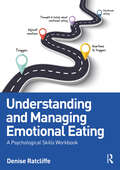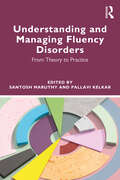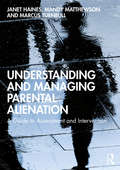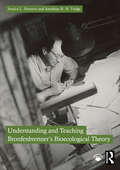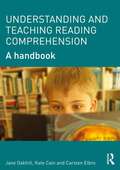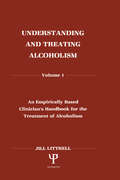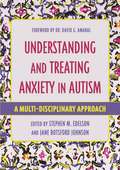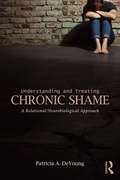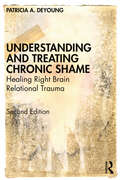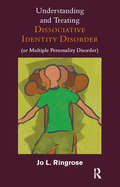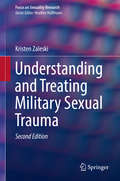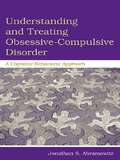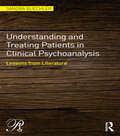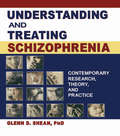- Table View
- List View
Understanding and Improving Information Search: A Cognitive Approach (Human–Computer Interaction Series)
by Herre Van Oostendorp Wai Tat FuThis edited book adopts a cognitive perspective to provide breadth and depth to state-of-the-art research related to understanding, analyzing, predicting and improving one of the most prominent and important classes of behavior of modern humans, information search. It is timely as the broader research area of cognitive computing and cognitive technology have recently attracted much attention, and there has been a surge in interest to develop systems and technology that are more compatible with human cognitive abilities. Divided into three interlocking sections, the first introduces the foundational concepts of information search from a cognitive computing perspective to highlight the research questions and approaches that are shared among the contributing authors. Relevant concepts from psychology, information and computing sciences are addressed. The second section discusses methods and tools that are used to understand and predict information search behavior and how the cognitive perspective can provide unique insights into the complexities of the behavior in various contexts. The final part highlights a number of areas of applications of which education and training, collaboration and conversational search interfaces are important ones. Understanding and Improving Information Search - A Cognitive Approach includes contributions from cognitive psychologists, information and computing scientists around the globe, including researchers from Europe (France, Netherlands, Germany), the US, and Asia (India, Japan), providing their unique but coherent perspectives to the core issues and questions most relevant to our current understanding of information search behavior and improving information search.
Understanding and Managing Emotional Eating: A Psychological Skills Workbook
by Denise RatcliffeThis highly accessible therapy workbook is designed to help individuals who are engaged in weight management and obesity treatments improve their relationship with food and manage their emotional eating.Emotional eating is a very common and distressing problem for many people who are trying to manage their weight. Emotional eating can contribute to weight gain and/or difficulties losing weight. It can also have a psychological impact, as people often feel very ashamed, frustrated and self-critical about their difficulties in stopping this behaviour. Instead of trying to address these emotional eating patterns through dieting or focusing on food, the approach presented in this workbook focuses on understanding the psychological and emotional drivers for the behaviour. Drawing on ideas from Cognitive-Behavioural Therapy, Compassion-focused Therapy and Acceptance and Commitment Therapy, the book is a step-by-step programme to help you develop a detailed understanding of the psychological drivers for your emotional eating behaviour and will help you develop a range of psychological strategies to manage your emotions and thoughts about food. The workbook contains practical resources and exercises, and by the end of the programme, you will have developed your own Emotional Eating Manual.This therapy workbook is for people who are unhappy with their emotional eating habits and the impact these have on their emotional health. It is also a valuable resource for therapists, dietitians and other allied professionals who work with this population.
Understanding and Managing Fluency Disorders: From Theory to Practice
by Santosh Maruthy Pallavi KelkarThis accessible book provides an overview of fluency disorders. Written by a team of speech-language pathology researchers and practitioners in India, it examines the concepts of fluency and disfluency with illustrative examples in English and Indian languages. Understanding and Managing Fluency Disorders gives an overview of current research and evidence-based practice in the context of a theoretical background. Clinical aspects of each fluency disorder are described, and the book outlines assessment protocols and intervention methods. Maruthy and Kelkar address key concepts related to different fluency disorders, including cluttering and acquired neurogenic stuttering. One of the highlights of the book is the chapter dedicated to typical disfluency, which could be of immense use to beginning clinicians who wish to increase the specificity and accuracy of their assessment. Other salient features include case vignettes, activity examples, easy steps to carry out intervention approaches and the added advantage of an ICF perspective, making this a practitioner’s guide to management of fluency disorders. Offering a comprehensive overview of theoretical and clinical aspects of stuttering, cluttering and fluency disorders, this volume will be highly relevant reading for students of fluency disorders and speech and language therapy. It will also provide clinicians and trainees working in the field with up-to-date theoretical and clinical information about assessment and intervention.
Understanding and Managing Neurodevelopmental Disorders in Children and Adolescents: A Pediatric Treatment Guide
by Denise E. MaricleChildren are being identified with more neurodevelopmental disorders than in previous decades and understanding these medically complex disorders has become critical as more children are living with these disorders.This pediatric treatment guide provides cutting-edge research and intervention recommendations for professionals working with children and adolescents. A team of contributors with diverse experience portray medically complex information and neurodevelopmental disorders in an accessible manner. Chapters include information on a range of disorders, such as: cystic fibrosis, diabetes, epilepsy, meningitis, chronic fatigue, and more. Each disorder’s physical and neurological manifestations are explored, as well as how the disorder is diagnosed and treated, and information regarding appropriate assessment and intervention. A list of further resources is included at the end of most chapters.This book is essential for practitioners working with children, including clinical psychologists, school psychologists, child neuropsychologists, clinical and school social workers, school nurses, pediatricians, and graduate students in training within various pediatric specialties.
Understanding and Managing Parental Alienation: A Guide to Assessment and Intervention
by Janet Haines Mandy Matthewson Marcus TurnbullIn Understanding and Managing Parental Alienation: A Guide to Assessment and Intervention, Janet Haines, Mandy Matthewson and Marcus Turnbull offer a comprehensive analysis of contemporary understanding of parental alienation. Grounded in recent scientific advances, this is the first book of its kind providing resources on how to identify parental alienation and a guide to evidence-based intervention. Parental alienation is a process in which one parent manipulates their child to negatively perceive and reject the other parent. Recognising this phenomenon and knowing when to intervene is often the biggest challenge faced by practitioners and this book provides a guide to this process. Divided into six parts, it examines what parental alienation is and how it is caused, how it affects each family member as a mental health concern and form of violence, and how to assess, identify and intervene successfully from a legal and therapy standpoint. Taking on a gender-neutral approach, the book is filled with contemporary case examples from male and female perspectives, cutting-edge research, practitioner-client dialogues, and practitioners’ reflections to show the difficult realities of parental alienation. Practical and accessible, this is an essential resource for mental health professionals working with families experiencing parental alienation, as well as postgraduate students of clinical psychology, counselling, family therapy, social work, and child and family psychology. This book will also be of immense interest to family lawyers and mediators due to its multidisciplinary approach.
Understanding and Preventing Violence: The Psychology of Human Destructiveness (Pacific Institute Series on Forensic Psychology)
by Leighton C. WhitakerMore violence has been perpetrated in the 20th century than in the two previous centuries combined. Understanding and Preventing Violence: Unmasking the Mentality of Human Destructiveness elucidates the mentality of destructive behavior with the hopes that in the future, the trend may be reversed through enlightenment. But in order to choose to be
Understanding and Supporting Children with Literacy Difficulties: An Evidence-Based Guide for Practitioners
by Valerie MuterLearning to read is arguably the single most important educational challenge a child faces in the first years of schooling, setting a child up for future academic success and opportunities. However, it is estimated that one in six children experience literacy difficulties. This is the go-to book for psychologists, educationalists and other professionals wanting a deeper understanding of current thinking around dyslexia, reading comprehension difficulties, and related SpLDs. Drawing on six fictional case studies to illustrate her points, and using examples of good practice throughout, Valerie Muter unpacks the latest psychological theories and research on literacy disorders. She discusses the interconnections between underlying cognitive problems and learning and educational and behavioural issues, as well as the common co-occurrence of these conditions. This authoritative book also provides accessible guidance on making assessments and tailoring interventions within the home or school.Written by a lead thinker in the field, this is an essential evidence-based guide for those working with children with literacy difficulties and supporting them to achieve their full potential.
Understanding and Supporting Professional Carers
by Janet ThomasThe National Service Framework for mental health aims to provide uniformly good systems so that mental health problems are detected and therefore treated early. This book sets out how learning more about mental health and reviewing current practice can be incorporated into a personal development plan or practice learning plan. It shows how to integrate quality improvements into everyday work and bridges the gap between theory and practice. Doctors nurses and practice managers can build up a personal development plan or a practice professional development plan through completing the exercises at the end of each chapter and it demonstrates how to include clinical governance in the mental healthcare services they offer.
Understanding and Teaching Bronfenbrenner's Bioecological Theory
by Jessica L. Navarro Jonathan R. TudgeClarifying misinterpretations of Bronfenbrenner's bioecological theory and offering a fresh perspective, this insightful book provides practical guidance for scholars on effectively teaching Bronfenbrenner’s theory at both undergraduate and graduate levels, as well as applying it in research and practice.The book traces the evolution of Bronfenbrenner’s theory of human development, from its original ecological framework of the 1970s to the fully developed bioecological theory and the Process-Person-Context-Time (PPCT) model. Key concepts such as macrosystemic influences are clarified, and innovative adaptations like inverse proximal process and neo-ecological theory are explored, addressing how virtual and digital contexts shape human development.The book offers adaptable strategies for applying Bronfenbrenner’s theory across a range of disciplines, demonstrating its versatility in undergraduate and graduate courses as well as in research. It includes practical teaching tools such as in-class activities, lecture slides and notes, reading primers, case studies, and discussion questions, equipping instructors with everything needed to teach Bronfenbrenner’s theory and its recent adaptations accurately and effectively.This resource is indispensable for instructors, researchers, and students eager to understand and apply the theory, as well as for anyone seeking a deeper understanding of human development in today’s complex, interconnected world.
Understanding and Teaching Reading Comprehension: A handbook
by Jane Oakhill Kate Cain Carsten ElbroThe ultimate aim of reading is not the process but to understand what we read and comprehension can take place at many different levels. There has been an increasing emphasis on the importance of reading comprehension in recent years but despite this there is very little written on this vital topic accessible to trainee and practicing teachers. The Handbook of Reading Comprehension presents an overview of recent findings on reading comprehension and comprehension problems in children. It provides a detailed examination of the characteristics of children who have reading comprehension difficulties, and examines ways in which comprehension can be supported and improved. It is accessibly written for students and professionals with no previous background in the psychology of reading or reading problems. This indispensable handbook asks the question ‘what is comprehension?’ The authors consider comprehension of different units of language: understanding single words, sentences, and connected prose and outline what readers (and listeners) have to do to successfully understand an extended text. This book also considers comprehension for different purposes, in particular reading for pleasure and reading to learn and explores how reader characteristics such as interest and motivation can influence the comprehension process. Different skills contribute to successful reading comprehension. These include word reading ability, vocabulary knowledge, syntactic skills, memory, and discourse level skills such as the ability to make inferences, knowledge about text structure, and metacognitive skills. The authors discuss how each one contributes to the development of reading comprehension skill and how the development of these skills (or their precursors) in pre-readers, provides the foundation for reading comprehension development. Areas covered include:- Word reading and comprehension Development of comprehension skills Comprehension difficulties Assessment Teaching for improvement Throughout the text successful experimental and classroom based interventions will be highlighted, practical tips for teachers and summary boxes detailing key points and explaining technical terms will be included in each chapter
Understanding and Teaching the Intuitive Mind: Student and Teacher Learning (Educational Psychology Series)
by Robert J. Sternberg Bruce TorffThe intuitive mind is a powerful force in the classroom and often an undetected one. Intuitive conceptions--knowledge or knowledge-structures that individuals acquire and use largely without conscious reflection or explicit instruction--sometimes work to facilitate learning in the classroom and other contexts. But learning may also be impeded by intuitive conceptions, and they can be difficult to dislodge as needed. The literatures in psychology and education include a large and diverse body of theory and research on intuitive conceptions, but this work is limited in some respects. This volume contributes in four ways to overcome these limitations. Understanding and Teaching the Intuitive Mind: Student and Teacher Learning: * pulls together diverse theoretical and methodological approaches to the origin, structure, function, and development of intuitive conceptions; * explores a diversity of academic disciplines--paying equal attention not only to mathematics and science, the fields in which intuitive concepts have been studied most extensively, but also to the social sciences, arts, and humanities; * explicitly links theory and research to educational implications and classroom applications; and * focuses not only on students' intuitive conceptions but also on teachers' intuitive beliefs about learning and teaching. Although the viewpoints of the contributors are diverse, they share the belief that educational practices have much to gain by systematic studies of the intuitive learner and teacher. This volume offers state-of-the-art, research-based information and support for psychologists, teacher educators, educational administrators, teachers, prospective teachers, and others who seek to develop educational practices that are cognizant of (and responsive to) the intuitive conceptions of students and teachers.
Understanding and Treating Alcoholism: Volume I: An Empirically Based Clinician's Handbook for the Treatment of Alcoholism:volume Ii: Biological, Psychological, and Social Aspects of Alcohol Consumption and Abuse
by Jill LittrellThere seems to be an abundance of "factual" information regarding alcoholism; what causes it, who is most susceptible, how it affects its victims, and how it should be treated. However, a definitive source of data supporting -- or refuting -- the numerous and diverse positions was never available. Thus, the goal of the author is to provide professionals with a solid understanding as to which "factual" statements about alcoholism are actually supported with evidence, and some of the empirically validated ways to proceed with treatment. Major methods of treatment are reviewed, and empirically based approaches are compared and contrasted with one another. Different and sometimes new focal points are explored, such as the disease concept of alcoholism, family members of alcoholics, personality characteristics, and effects of alcoholism exclusive to women. Also notable is the nearly unprecedented look into the impact of alcohol on all types of mood and behavior, rather than just on aggression -- a topic long since exhausted. A comprehensive review of literature, complemented with critiques of research, this two-volume set is a thorough, informative source of reference for anyone who seeks to further their knowledge of this often misunderstood, yet unfortunately all too common phenomenon.
Understanding and Treating Anxiety in Autism: A Multi-Disciplinary Approach
by Stephen M. Edelson and Jane Botsford JohnsonAnxiety is a prevalent and often debilitating condition for individuals on the autism spectrum. This book promotes a multidisciplinary approach to intervention and treatment of the condition, providing professional understanding of the underlying causes and available treatments. With chapters co-authored by well-known advocates and pioneering researchers, contributors examine factors including sensory processing issues, sleep impairments and the crossover between the autonomic nervous system and immune system. The book expands upon current areas of research, including immune activation and the role of environmental toxicants, dietary and nutritional support, the treatment of gastrointestinal disorders and individualised methods of managing stress and anxiety. Providing an invaluable resource for professionals and academics seeking further insight into anxiety and autism, this book explores contemporary research and sets the groundwork for the most effective methods of treatment for individuals of all ages.
Understanding and Treating Chronic Shame: A Relational/Neurobiological Approach
by Patricia A. DeYoungChronic shame is painful, corrosive, and elusive. It resists self-help and undermines even intensive psychoanalysis. Patricia A. DeYoung’s cutting-edge book gives chronic shame the serious attention it deserves, integrating new brain science with an inclusive tradition of relational psychotherapy. She looks behind the myriad symptoms of shame to its relational essence. As DeYoung describes how chronic shame is wired into the brain and developed in personality, she clarifies complex concepts and makes them available for everyday therapy practice. Grounded in clinical experience and alive with case examples, Understanding and Treating Chronic Shame is highly readable and immediately helpful. Patricia A. DeYoung’s clear, engaging writing helps readers recognize the presence of shame in the therapy room, think through its origins and effects in their clients’ lives, and decide how best to work with those clients. Therapists will find that Understanding and Treating Chronic Shame enhances the scope of their practice and efficacy with this client group, which comprises a large part of most therapy practices. Challenging, enlightening, and nourishing, this book belongs in the library of every shame-aware therapist.
Understanding and Treating Chronic Shame: Healing Right Brain Relational Trauma
by Patricia A. DeYoungA masterful synthesis of relational and attachment theory, neurobiology, and contemporary psychoanalysis, Understanding and Treating Chronic Shame has been internationally recognized as an essential text on shame. Integrating new theory about trauma, shame resilience, and self-compassion, this second edition further clarifies the relational, right-brain essence of being in and with the suffering of shame. New chapters carry theory further into praxis. In the time of a national Truth and Reconciliation Commission and a global Black Lives Matter movement, "Societies of Chronic Shame" invites therapists to deepen their awareness of collective societal trauma and of their own place within dissociated societal shame. "Three Faces of Shame" organizes the clinical wisdom of the book into clear guidelines for differential diagnosis and treatment. Lucid and compassionate, this book engages with the most profound challenges of clinical practice and touches into the depths of being human.
Understanding and Treating Dissociative Identity Disorder (or Multiple Personality Disorder)
by Jo L. RingroseThis book provides all of the information a practitioner needs in order to begin work with clients with Dissociative Identity Disorder (DID). Drawing on experiences from her own practice and extensive research conducted with the help of internationally acclaimed experts in the field, the author describes the development of DID and the structure of the personality of these clients. The reader is guided through the assessment process, the main phases and components of treatment, and the issues and contentions that may arise in this work. Throughout the text there are case examples, practical exercises, techniques, and strategies that can be used in therapy sessions. The resources section includes screening and assessment instruments, as well as information on techniques for managing anxiety and self harm, both of which can be major problems when working with clients with DID.
Understanding and Treating Dissociative Identity Disorder: A Relational Approach (Relational Perspectives Book Series)
by Elizabeth F. HowellBuilding on the comprehensive theoretical model of dissociation elegantly developed in The Dissociative Mind, Elizabeth Howell makes another invaluable contribution to the clinical understanding of dissociative states with Understanding and Treating Dissociative Identity Disorder. Howell, working within the realm of relational psychoanalysis, explicates a multifaceted approach to the treatment of this fascinating yet often misunderstood condition, which involves the partitioning of the personality into part-selves that remain unaware of one another, usually the result of severely traumatic experiences. Howell begins with an explication of dissociation theory and research that includes the dynamic unconscious, trauma theory, attachment, and neuroscience. She then discusses the identification and diagnosis of Dissociative Identity Disorder (DID) before moving on to outline a phase-oriented treatment plan, which includes facilitating a multileveled co-constructed therapeutic relationship, emphasizing the multiplicity of transferences, countertransferences, and kinds of potential enactments. She then expands the treatment possibilities to include dreamwork, before moving on to discuss the risks involved in the treatment of DID and how to mitigate them. All concepts and technical approaches are permeated with rich clinical examples.
Understanding and Treating Incels: Case Studies, Guidance, and Treatment of Violence Risk in the Involuntary Celibate Community
by Chris Taylor Brian Van BruntUnderstanding and Treating Incels is an indispensable guide for mental health clinical staff, social workers, prevention specialists, educators, and threat assessment professionals who want to better understand the involuntary celibate movement, assess individuals’ potential for violence, and offer treatment approaches and prevention efforts. Chapters explore the movement in terms of gender, technology, the media, and pornography usage. The book discusses how the incel mentality has motivated individuals to misogynistic worldviews and increased rage and disillusionment, and inspired acts of targeted violence such as school shootings and mass casualty events. Later chapters walk the reader through three cases studies and offer treatment considerations to assist mental health professionals and those developing education and prevention-based programming. The complete text gives the reader useful perspectives and insights into incel culture while offering mental health clinicians and educators guidance on treatment and prevention efforts.
Understanding and Treating Military Sexual Trauma
by Kristen ZaleskiThis thorough analysis of sexual assault in the military examines the scope of this long-neglected issue using a lens informed by modern day attachment and trauma theories. Starting with an overview of sexual violence during wartime, it details the cultural and organizational aspects of military life--and entrenched ideas about war and masculinity--that compound military sexual trauma (MST) and reinforce barriers to treatment for women and men. The book's second half reviews empirically-supported interventions for MST survivors, recommending therapy that attends to somatic, implicit, relational based aspects of trauma processing rather than the conventional cognitive therapies currently funded in many military mental health programs. This powerful presentation, which includes sobering quotes from survivors, also raises serious questions about meeting veterans' needs, training for on- and off-base clinicians, and government funding. Included in the coverage: The history of sexual violence in war. Trauma and recovery in military culture. The neurobiology of trauma. A military rape sub-culture hypothesis about the hidden sexual assault epidemic. How military culture and military law affect the immediate aftermath of MST. Treating the trauma and not just the memory. Questions the "one size fits all" approach of many trauma therapies for MST. Top-down cognitive-based treatment for MST. Body-based bottom-up psychotherapy for MST. Understanding and Treating Military Sexual Trauma belongs in the libraries of private practice clinicians and government psychologists. It provides cutting edge knowledge to practitioners in training, such as graduate-level students studying psychology and social work. Its dual emphasis on military culture and women's lives will appeal to students in gender studies, sociology and program planning disciplines.
Understanding and Treating Military Sexual Trauma (Focus On Sexuality Research Ser.)
by Kristen ZaleskiThis authoritative update presents current findings on—and clinically and ethically sound responses to—the epidemic of sexual assault in the military. It examines in powerful detail how military culture enables a pervasive subculture of sexual violence, from consistently devaluing women to blaming victims and denying them justice. The author’s dual attachment/trauma theory lens attends to a wide range of outcomes such as unit members closing ranks against survivors and the continuing impact of assault trauma on veterans’ lives. And the book’s second half critiques standard forms of treating military sexual trauma in favor of individualized therapy addressing the physical, psychological, and neurological aspects of trauma and recovery. This important volume covers: · Theory and history of sexual violence as a weapon of war.· Legal and health considerations in the aftermath of military sexual assault.· Critical distinctions between military and civilian legal response to sexual assault.· Variations in symptomology among survivors.· Specific barriers to services for male and LGBT survivors.· New and emerging treatment options for military sexual trauma/PTSD. This Second Edition of Understanding and Treating Military Sexual Trauma follows its predecessor as an essential reference on its subject for mental health clinicians treating sexual trauma in the military as well as trauma researchers, sociologists, women’s health practitioners, and university students whose focus is women’s studies, public policy, public health, social work, psychology, sociology, or political science.
Understanding and Treating Military Sexual Trauma (Focus on Sexuality Research)
by Kristen ZaleskiThis thorough analysis of sexual assault in the military examines the scope of this long-neglected issue using a lens informed by modern day attachment and trauma theories. Starting with an overview of sexual violence during wartime, it details the cultural and organizational aspects of military life--and entrenched ideas about war and masculinity--that compound military sexual trauma (MST) and reinforce barriers to treatment for women and men. The book's second half reviews empirically-supported interventions for MST survivors, recommending therapy that attends to somatic, implicit, relational based aspects of trauma processing rather than the conventional cognitive therapies currently funded in many military mental health programs. This powerful presentation, which includes sobering quotes from survivors, also raises serious questions about meeting veterans' needs, training for on- and off-base clinicians, and government funding. Included in the coverage: The history of sexual violence in war.Trauma and recovery in military culture.The neurobiology of trauma.A military rape sub-culture hypothesis about the hidden sexual assault epidemic.How military culture and military law affect the immediate aftermath of MST.Treating the trauma and not just the memory.Questions the “one size fits all” approach of many trauma therapies for MST.Top-down cognitive-based treatment for MST.Body-based bottom-up psychotherapy for MST.Understanding and Treating Military Sexual Trauma belongs in the libraries of private practice clinicians and government psychologists. It provides cutting edge knowledge to practitioners in training, such as graduate-level students studying psychology and social work. Its dual emphasis on military culture and women's lives will appeal to students in gender studies, sociology and program planning disciplines.
Understanding and Treating Obsessive-Compulsive Disorder: A Cognitive Behavioral Approach
by Jonathan S. AbramowitzAmong the most prevalent and personally devastating psychological disorders the development of a cognitive approach to obsessive compulsive disorder (OCD) has transformed our understanding and treatment of it. In this highly practical and accessible book, Jonathan Abramowitz presents a model of OCD grounded in the most up-to-date research that incorporates both cognitive and behavioral processes. He then offers a step-by-step guide to psychological treatment that integrates psychoeducation, cognitive techniques, and behavioral therapy (exposure and response prevention). Unlike other manuals for the treatment of OCD, this book teaches the reader how to tailor the choice of techniques and delivery modes for individuals presenting with a wide range of specific OCD symptoms, such as contamination fears and cleaning rituals, fears of harm and compulsive checking, symmetry and ordering, and severe obsessions with mental rituals. The techniques are illustrated with numerous case examples; clinical forms and handouts are provided for use with patients. A final chapter suggests strategies for overcoming common obstacles in treatment.
Understanding and Treating Patients in Clinical Psychoanalysis: Lessons from Literature (Psychoanalysis in a New Key Book Series)
by Sandra BuechlerUnderstanding and Treating Patients in Clinical Psychoanalysis: Lessons from Literature describes the problematic ways people learn to cope with life’s fundamental challenges, such as maintaining self-esteem, bearing loss, and growing old. People tend to deal with the challenges of being human in characteristic, repetitive ways. Descriptions of these patterns in diagnostic terms can be at best dry, and at worst confusing, especially for those starting training in any of the clinical disciplines. To try to appeal to a wider audience, this book illustrates each coping pattern using vivid, compelling fiction whose characters express their dilemmas in easily accessible, evocative language. Sandra Buechler uses these examples to show some of the ways we complicate our lives and, through reimagining different scenarios for these characters, she illustrates how clients can achieve greater emotional health and live their lives more productively. Drawing on the work of Dostoevsky, Tolstoy, Munro, Mann, James, O’Connor, Chopin, McCullers, Carver, and the many other authors represented here, Buechler shows how their keen observational short fiction portrays self-hurtful styles of living. She explores how human beings cope using schizoid, paranoid, grandiose, hysteric, obsessive, and other defensive styles. Each is costly, in many senses, and each limits the possibility for happiness and fulfillment. Understanding and Treating Patients in Clinical Psychoanalysis offers insights into what living with and working with problematic behaviors really means through a series of examples of the major personality disorders as portrayed in literature. Through these fictitious examples, clinicians and trainees, and undergraduate and graduate students can gain a greater understanding of how someone becomes paranoid, schizoid, narcissistic, obsessive, or depressive, and how that affects them, and those around them, including the mental health professionals who work with them.
Understanding and Treating Schizophrenia: Contemporary Research, Theory, and Practice
by Terry S Trepper Glenn D SheanGet a fair and balanced perspective on schizophrenia! Understanding and Treating Schizophrenia: Contemporary Research, Theory, and Practice is a comprehensive overview of schizophrenia and its treatment from a variety of approaches. The book presents a balanced look at the most influential theoretical perspectives based on empirical research, clinical descriptions, and narrative histories. Dr. Glenn Shean, author of Schizophrenia: An Introduction to Research and Theory, examines neurocognitive and neurodevelopmental models of brain dysfunction, psychodynamic and family factors, up-to-date pharmacological advances, and successful community programs for discharged patients suffering from this debilitating disorder. Understanding and Treating Schizophrenia: Contemporary Research, Theory, and Practice presents a comprehensive review of evidence concerning the epidemiology and course and outcome of schizophrenia based on theoretical groupings and levels of analysis. The book examines the evolution of diagnostic criteria and guidelines, as well as stress-vulnerability and diathesis-stress models, providing critical reviews of biological, genetic, cognitive-behavioral, and phenomenological, approach to understanding and treating schizophrenia. Topics addressed in Understanding and Treating Schizophrenia: Contemporary Research, Theory, and Practice include: the history of the concept of schizophrenia the writings of Emil Kraepelin and Eugene Bleuler changes in diagnostic guidelines in the last 50 years General System Theory Perspective diagnostic and statistical manuals Schneider's first rank symptoms and much more! Understanding and Treating Schizophrenia: Contemporary Research, Theory, and Practice is an essential resource for undergraduate and graduate students working in psychology, psychiatry, nursing, social work, and social policy.
Understanding and Treating Self-Injurious Behavior in Autism: A Multi-Disciplinary Perspective
by Temple Grandin John Green Nancy O'Hara Manuel F. Casanova Lucy Jane Miller Margaret L. Bauman V. Mark Durand June Groden Cooper R. Woodard Harumi Jyonouchi Paul Millard Hardy Stephen M. Edelson Kelly Mccracken Barnhill Mary Coleman Emily L. Casanova Karen Misher Leslie Weidenman Jane Botsford Johnson Lauren J. Moskowitz Jamie D. Bleiweiss Alexis B. Ritter Caitlin E. WalshSelf-injurious behavior occurs in almost half of those with autism and is one of the most devastating and challenging-to-treat behaviors. There are many different forms of self-injury, such as head banging, hand biting, hair pulling, excessive scratching, and much more. With contributions from the leading experts in research and treatment, the book provides a comprehensive analysis of self-injurious behavior (SIB) in people with Autism Spectrum Disorder (ASD) or related developmental disabilities, and the different methods available to treat them. Medical and behavioral researchers have studied SIB for over 50 years, but many practitioners and parents are still unfamiliar with the wide range of contributing causes and treatment options. Beginning with an explanation of SIB and its various forms, the contributors outline the many possible underlying causes of self-injury, such as seizures, hormonal imbalance in teenagers, gastrointestinal conditions, allergies, and stress, and show how a multi-disciplinary approach when uncovering the causes of self-injury can lead to successful treatment strategies. They explain the treatment options available for SIB, including nutritional, medical, psychiatric, sensory, and behavioral approaches, and show how an integrative approach to treating self-injury may be effective for many individuals. The book will be an invaluable addition to the bookshelves of any practitioner working with people with an ASD or related condition, as well as parents and direct care providers.

